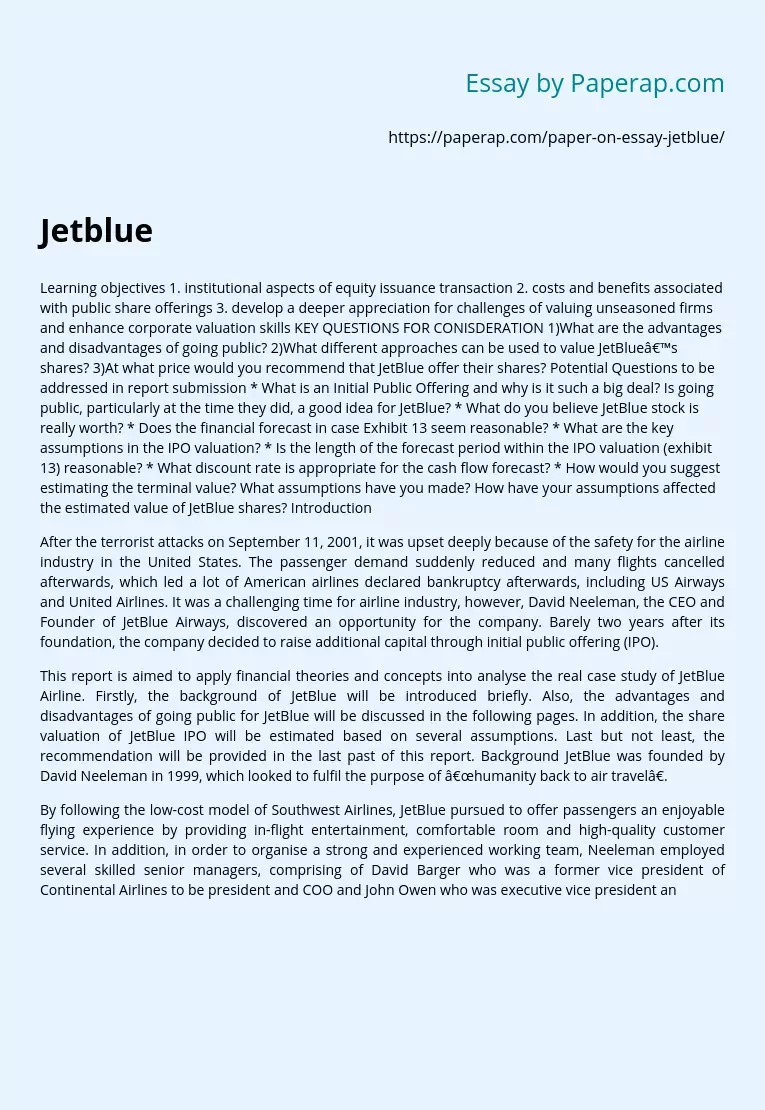Jetblue and FCFF
After the terrorist attacks on September 11, 2001, it was upset deeply because of the safety for the airline industry in the United States. The passenger demand suddenly reduced and many flights cancelled afterwards, which led a lot of American airlines declared bankruptcy afterwards, including US Airways and United Airlines. It was a challenging time for airline industry, however, David Neeleman, the CEO and Founder of JetBlue Airways, discovered an opportunity for the company. Barely two years after its foundation, the company decided to raise additional capital through initial public offering (IPO).
This report is aimed to apply financial theories and concepts into analyse the real case study of JetBlue Airline. Firstly, the background of JetBlue will be introduced briefly. Also, the advantages and disadvantages of going public for JetBlue will be discussed in the following pages. In addition, the share valuation of JetBlue IPO will be estimated based on several assumptions. Last but not least, the recommendation will be provided in the last past of this report.
Background JetBlue was founded by David Neeleman in 1999, which looked to fulfil the purpose of “humanity back to air travel”.
By following the low-cost model of Southwest Airlines, JetBlue pursued to offer passengers an enjoyable flying experience by providing in-flight entertainment, comfortable room and high-quality customer service. In addition, in order to organise a strong and experienced working team, Neeleman employed several skilled senior managers, comprising of David Barger who was a former vice president of Continental Airlines to be president and COO and John Owen who was executive vice president and former treasurer of Southwest Airlines to be CFO in JetBlue.
Moreover, as the founder of JetBlue, Neeleman have own extensive experience with airline start-ups from managing low-fare flights during university period. Based on the explicit marketing strategy of JetBlue, barely less than one year, the company increased the routes to other cities in America and it continued to grow rapidly to 17 destinations in early 2002.
And not only that, JetBlue adopted the active measures to increase expenditures for security by setting up equip cockpits with bulletproof doors and security cameras, which enhanced the confidence of US residences to take flights under the circumstance of few people was afraid of flying after September 11 hijackings. Advantages and disadvantages of going public Refer to Bodie, Kane and Marcus (2011), initial public offerings are stocks issued by a formerly privately owned company that is going public, which means that selling stock to the public for the first time.
For example, the contagion of bird flu was quite severe during taking flights, which definitely influenced the demand of flights. The increasing oil price also raised the basic cost in any transportation industry. Another negative condition could be the economic downturn, including crash of the dot-com bubble and financial crisis in Asia. From this point of view, it seemed not to be an appropriate time to going public. However, faced with the weak financial markets, JetBlue measured the targeted strategies and made success in profitable operations.
And IPO market is never dead for good company with real revenues and real earnings just like JetBlue. It then turned out that it was a suitable time for JetBlue to IPO during the economic downturn though. JetBlue’s shares valuation There are various methods to value shares for a company, including free cash flow to equity (FCFE) method discounted by WACC, free cash flow to firm (FCFF) method discounted by cost of equity, dividend discount model and relative valuation techniques. Since JetBlue had not paid out any dividends on common stock, dividend discount model cannot be used to estimate company share value.
In addition, FCFF method do not consider the effect of interest payment, however, as mentioned in the case, the Federal Reserve had attempted to stimulate economic activity by reducing interest rates. Therefore, from my point of view, it was more appropriate to value JetBlue share by FCFE method to consider the consequences of interest rate. The assumptions are made for evaluate JetBlue share value as follows. The long-run growth rate was expected to be 7% annually. And the company would have survived and would be a typical firm with an estimated cost of equity of 15% in 2010.
Last but not least, the appropriate discount rate was assumed to be 30%. Additionally, there was a quite weird number disappeared in the Exhibit 13, which was the expected inflation rate was 4 times in 2002 than other years. After changing it back to the normal, the share value then could be calculated to be around $24. 60 per share. Based on the assumptions, the calculated consequence is identical to the initial offering prices which ranged from initial price to implemented offering price ($24 to $25).
Faced with sizable excess demand to potential investors, JetBlue took the appropriate measure to increase share value in order to avoid “money leave on the table”. In the long run, I believe that JetBlue will still grow at a stable stage as the innovative spirit and seasonable measures to the different types of events. Therefore, JetBlue’s stock was worth for the potential and incoming investors. We prepared to retristrict initial registration with SEC for the IPO on September 11, 2001. Based on the event of that morning, we didnot .
We waited until stock market settled down. We returned the profitability in November and December. We started to issue IPO gain in Christmas time. Obviously, we modified the document a bit. High growth, low cost profitable airline has rebounded substantially in the market place. It was a very good stands to do the IPO for JetBlue. Even though it was 2002, the IPO market was pretty much dead, the IPO market is never dead for good company with real revenues and real earnings.
Jetblue and FCFF. (2019, Jun 20). Retrieved from https://paperap.com/paper-on-essay-jetblue/

